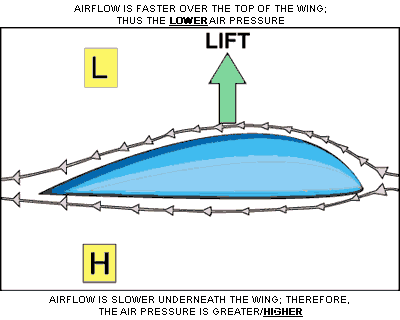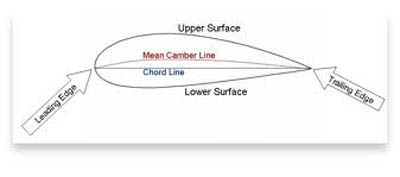Wing Sections and Lift
Lift is a wonderful thing, try to imagine a world without it, so much of today's life has something to do with lift, either directly or indirectly. Direct relationship is easy to work out, aircraft for example!!! Indirect is a little more difficult, but the basics of this indirect relationship is simple, if it wasn't for an aircraft's lift force there are many comforts we wouldn't have today, like satellite TV, satellites need to get into space, and they do so thanks to spacecraft, yes most of them are rockets, but the space shuttle is a very basic glider, or more accurately a lifting body, an object that creates enough lift for it to be under controlled flight to get back to Earth. Cars are another example, the aerodynamics of cars is now a large consideration in car design itself, you can see it in the nice smooth aerodynamic lines of its design, and especially these days on the rear spoiler, it is simple an upside down wing designed to generate lift, but upside down to push the rear of the car down on the road an improve traction. Race cars can't do without a rear wing, I have seen footage of a high speed race car when its wing snapped in half, the back of the car went out of control and the driver only just managed to control it and get it back to the pits. All said and done, if it wasn't for aircraft design race cars would not be where they are today, especially formula 1.....
So let's look at lift, we covered earlier the idea of Bernoulli's theory and the convergent divergent duct, well a wing is simply half of the duct, the bottom of the wing (a very basic one) is flat, while the top surface is curved, because of this the air flowing over the top need to travel further to meet the air again at the other end, to do so it speeds up, when the air over the top speeds up its static pressure drops, therefore there is low pressure over the wing and higher pressure under the wing, bingo, you have lift, simple as that.

Yes it does get a whole lot more complicated than that when you want to talk efficiency and performance etc, and that will come soon, but for now it is simple and if you don't want to go any deeper than that's fine. For those that do want to go deeper then read on, though before I do I will start to cover some more of the theory and terminology, so as to better understand what is happening in the design of a wing and the way air flows over it. Another name for a wing is aerofoil, though the word aerofoil is more used to describe the cross section of a wing, its shape if you cut it in half from front to back, or leading to trailing edge. Some terminology before we go any further, the leading edge is the forward most tip of the wing aerofoil, the trailing edge is the most rearward point of the wing, if you draw a line from leading to trailing edge it is called the chord line. The chord line is not necessarily the centre of the wing section or aerofoil, if the aerofoil was exactly the same shape on top and the bottom it is called a symmetrical wing, therefore the chord line would be exactly in the middle. However not many wings are perfectly symmetrical, so the half way point between the top and the bottom surface of the aerofoil is called the mean camber line.
So we have covered the basics of lift and some terminology related to the design of a wing, next we will look into the various elements of the wings interaction with air and the practicalities of lift creation, and the point were the lift just isn't enough, and the wing stall takes palce.
